Samsung M5 Review
Samsung M5
Make multiroom easy with Samsung’s superb streaming speaker
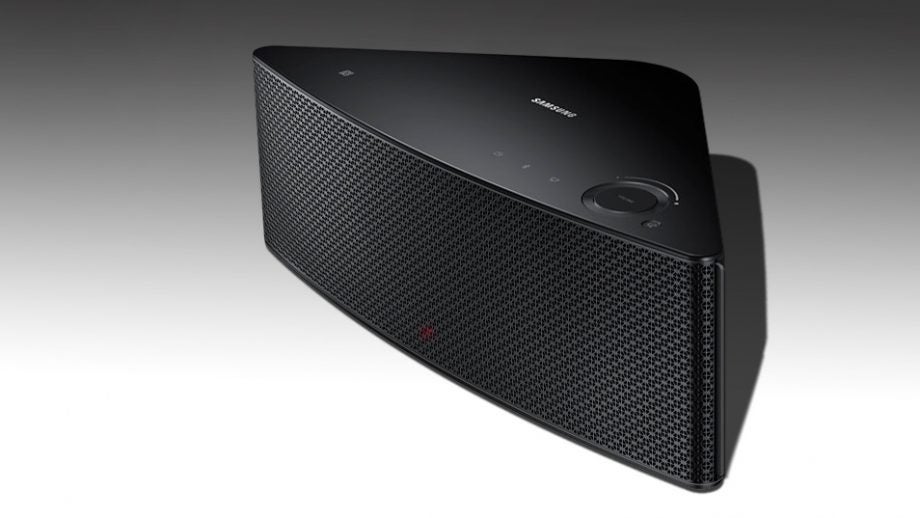
Verdict
Pros
- Distinctive design
- Full-bodied sound with crisp detail
- Easy-to-use smartphone app
Cons
- Occasionally overwhelming bass
- Not enough of a step up from the M3
- No audio inputs
Key Specifications
- Review Price: £229.99
- Single speaker or multiroom use
- DLNA, Bluetooth, NFC and TV SoundConnect support
- Spotify, Deezer, Napster, 8tracks, Murfie, Qobuz, Tunein Radio and Rdio
- MP3, WMA, AAC, OGG, WAV and FLAC playback
What is the Samsung M5?
The M5 (or WAM550) is the middle man in Samsung’s range of wireless speakers, sitting between the entry-level M3 – which scooped Best Wireless Speaker in the TrustedReviews Awards 2014 – and the top-end M7. There’s a £70 premium on the price of the M3, but it’s around £100 cheaper than the M7.
The M5 can be used as a single wireless speaker for DLNA or Bluetooth streaming, but the beauty is that you can buy additional speakers to create a multiroom system, or team up two or more speakers in a stereo/surround setup – all orchestrated by Samsung’s smartphone app and Wi-Fi hub.
This flexibility is what we loved about the M7 and M3, as well as their impressive sound quality and stylish design, and we’re hoping the M5 can follow in their footsteps.
SEE ALSO: Best Wireless Speakers Round-up
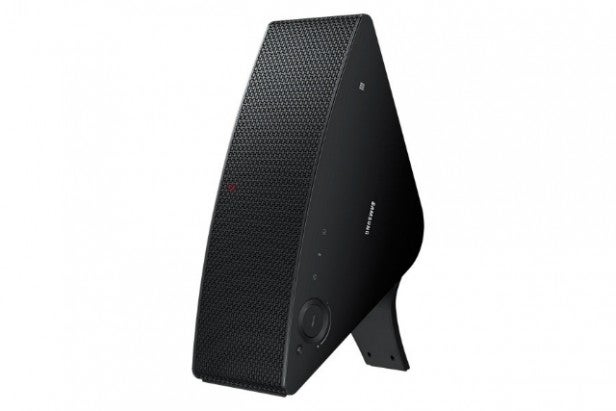
Samsung M5 – Design
The M5’s distinctive design is identical to that of the M3 and M7, with a groovy triangular shape that’s meant to look like a play button. But the main difference between the three is size – at 342mm wide, the M5 is the ‘medium’ model, while the smaller M3 measures 250mm wide and the M7 measures 402mm. The compact shape makes it easy to accommodate on furniture or shelves. The cabinet is solid and weighty, although the glossy top panel feels plasticky.
It’s designed to be lie horizontally when used as a single speaker, but in a two-channel or surround system you can place it on its side using the supplied stand. When you do so, a built-in sensor switches the speaker to mono. The M5 can also be mounted on the wall using the threaded hole on the back.
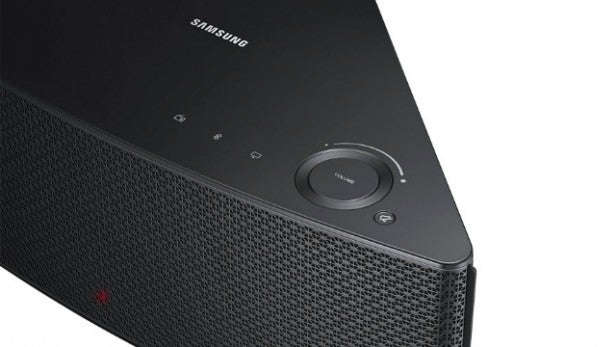
With a button-free fascia, curvy corners and a glamorous gloss-black finish, the look is sleek and minimal – it’s likely to be quite the talking point. An LED shines through the front grille in different colours to denote status, while a few touch-sensitive controls on top allow you to select internet radio presets, pair Bluetooth devices, adjust volume and activate TV SoundConnect. There’s no power button, but it goes to sleep after a while, or you can force it into a snooze by holding down the Mute button.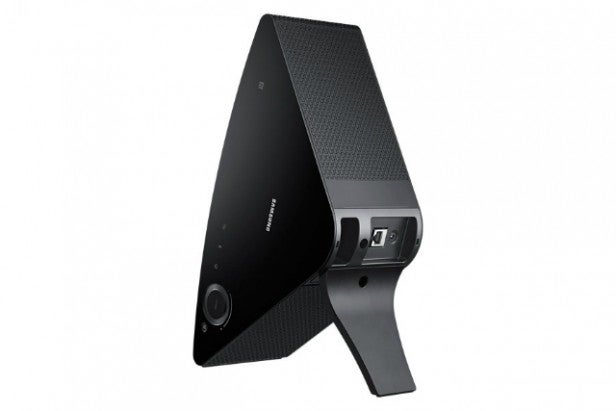
It’s a wireless speaker so don’t expect many sockets – the recess on the back houses a USB port for service use and an Ethernet port for those who prefer a wired connection to a router. There are two buttons, one for WPS Wi-Fi setup and another that you press when adding the speaker to a multiroom system. It’s slightly disappointing that you can’t hook up non-wireless devices but not a deal-breaker.
Samsung M5 – Features
Despite its modest appearance the M5 is bursting with functionality, much of which is located within Samsung’s brilliant Multiroom app. It allows you to stream music from a variety of online services – Spotify, Deezer, Napster, 8tracks, Murfie, Qobuz – plus Internet radio from Tunein and Rdio.
We’ve touched upon Bluetooth and DLNA, but there’s also support for NFC (not found on the M3) and TV SoundConnect, plus playback of MP3, WMA, AAC, OGG, WAV, FLAC, ALAC and AIFF (up to 192kHz/24-bit). The M5 is equipped with two 56mm drivers and an 80mm woofer, driven by digital amplifiers. Samsung hasn’t quoted a power rating for the amps.
Samsung M5 – Setup and Operation
Some wireless speakers can be a pain to setup, but the M5 is a piece of cake, particularly if you invest in Samsung’s £50 Hub (WAM250), which acts as a go-between for your router and the M5. Connect the Hub to your router using a LAN cable and it creates a Wi-Fi network to link up all your M5s.


The Hub is a compact black box with three illuminated icons on the front indicating power, Wi-Fi status and Ethernet connection. There are two LAN ports on the back and USB port for service use.
If you’re only using a single M5 you can connect it to your home network without a Hub using the WPS Wi-Fi button on the back or by connecting it directly with a LAN cable. But the Hub certainly makes installation easier, and you’ll definitely need one for multiroom use.
When you power up the M5, it connects to the Hub automatically. If not, pressing the Speaker Add button should prompt it to do so. Once everything’s connected, you need to install and run Samsung’s Multiroom app on a smartphone connected to the same network.
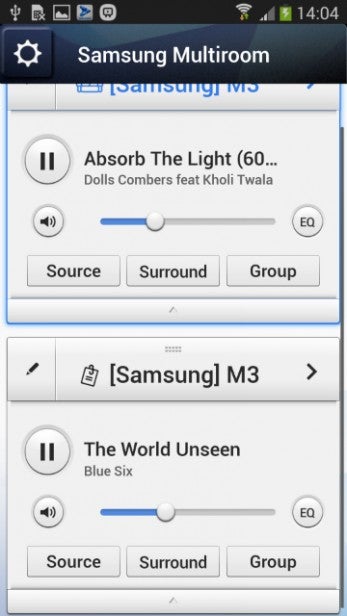
Fire up the app and it finds any M5s on the network, presenting each one in its own box with a series of options along the bottom. ‘Source’ lets you choose where to pull music from (Wi-Fi, Bluetooth or TV SoundConnect); ‘Surround’ lets you arrange multiple M5s in a stereo or surround layout by dragging them to the right place on the diagram (a sexy female voice confirms your choice); while ‘Group’ lets you play the same music through several speakers at the same time – just tick the speakers you want to include.
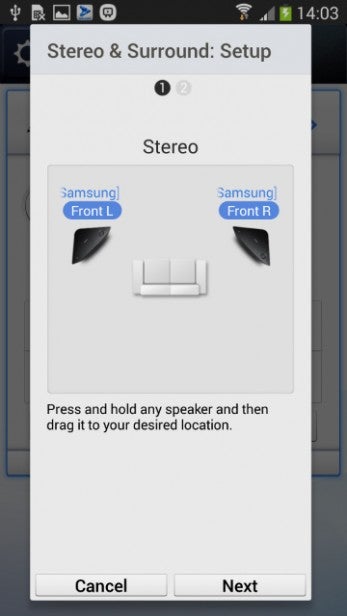
You can rename each speaker (helpful for labelling them by room) and tweak the bass, treble, balance and DRC. In Surround mode you’ll see a single box that lets you take control of the whole system.

To select music, tap the name of the speaker and you move to the content selection menu. A row of tabs along the top lets you browse music stored on the phone or jump to Tunein or Spotify (you’ll need a premium account for the latter).

The Devices option lets you explore any connected DLNA servers. The menus are clear, thoughtfully sequenced and attractively decorated with cover art and groovy graphics. During playback you can see the track list by dragging the screen up from the bottom, plus you can easily adjust volume, skip tracks and select playback modes. It really is a joy to use.
Samsung M5 – Performance
The M5’s strong and stable wireless connection allowed us to stream music for hours without any drop outs or interference. If your M5 is too far from the Hub, you can use another Hub to act as a repeater and expand wireless coverage (although obviously that’ll bump up the cost considerably).
Its sound quality is superb. Like the M3 and M7 before it, the M5 is remarkably powerful for such a compact unit, flooding the room with a big, full-bodied sound. Deep bass gives music a feeling of warmth and solidity, which works particularly well when playing uptempo tracks with thumping drums and pulsating basslines, although it can seem a little too thick at times – if that’s a problem, you can always tweak the EQ within the app.
Also impressive is the M5’s high-frequency reproduction, which makes songs sound detailed and lively without over-stressing hi-hats and percussion, even when you turn the volume up loud. It teases out delicate sounds like shakers and tambourines and gives strings and vocals a silky, natural quality.
If you pair up two M5s in a stereo setup you get an even bigger sound with a slight step-up in volume and presence over the M3. The two-channel stage is spacious and expertly organised – sounds pan between the two speakers seamlessly and vocals are locked in the middle. Fans of a leaner sound might find the bass levels a little full-on but otherwise the sound is highly enjoyable.
Pair a Samsung TV with an M5 via SoundConnect and its fulsome output effortlessly brings scale to movies and programmes, bulking up the bass and sharpening up speech. And with an M5 either side of the TV you get a massive movie soundstage that puts some soundbars to shame.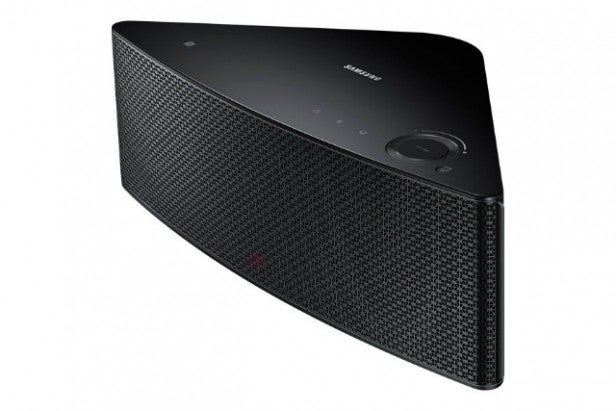
Should I buy the Samsung M5?
Like its two stablemates, the M7 and M3, the M5 is a terrific wireless speaker that boasts tons of functionality, a chic design and simple, flexible operation. Setting up and orchestrating a multiroom system is remarkably easy thanks to Samsung’s slick smartphone app, while support for Bluetooth, TV SoundConnect and a wide range of audio codecs is a bonus.
It’s an impressive performer too, filling the room with a big, beefy sound and digging out plenty of detail. Some might find the bass a bit full-on but it does ensure that the sound has plenty of depth and punch. For these reasons, the M5 is definitely worthy of your hard-earned cash – although at £70 more than the similar-sounding M3 it doesn’t quite offer the same value for money and therefore just misses out on full marks.
SEE ALSO: Best Soundbars Round-up
Verdict
Samsung shows its rivals how multiroom should be done with its slick, stylish and user-friendly wireless speaker.
Trusted Score
Score in detail
-
Performance 9
-
Features 9
-
Value 9
-
Sound Quality 9
-
Design 9
Features
| 3D Ready | No |
| Number of Speakers | 2 |
| Supported Channels | 2 |
Connectors
| Power (Watt) | Not givenW |
Physical Specifications
| Height (Millimeter) | 113.2mm |
| Width (Millimeter) | 342.5mm |
| Depth (Millimeter) | 168mm |
| Weight (Gram) | 2.3g |

